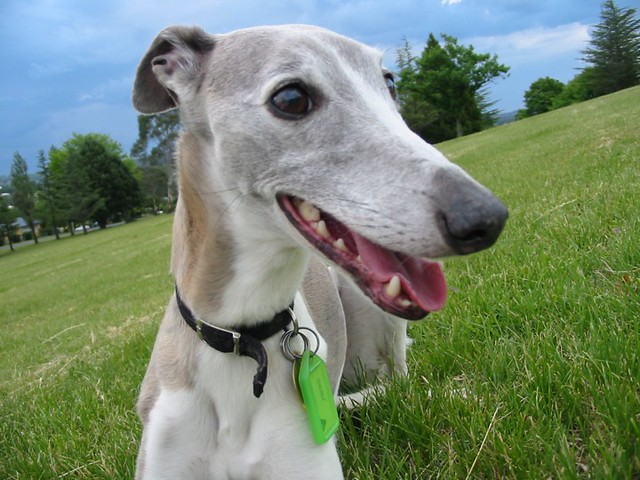(Original Title: Whippet Dog Breed Profile Information)
 |
| Photo by Tai McQueen |
Description:
The Whippet is a medium-sized dog in the sighthound group. The dog will be 19 to 22 inches at the shoulder and the bitch 18 to 21 inches. This dog can range in weight from about 25 to 45 pounds. The Whippet is a very streamlined dog with a long neck and legs. The chest is deep for aid in running. The short coat of the Whippet can be found in nearly all colors including white with brindle, white with black, yellow patches, blue, or red. The color may also be solid. The Whippet will live for approximately 12 to 15 years. The name comes from the expression "whip it", which meant to do something quickly. This dog is also known as the Snapdog.
History:
The Whippet was bred from the Greyhound, the Italian Greyhound, and an unknown terrier at the end of the 1800s in England. The Whippet found itself used as a hunter of rabbits by the peasants, but became a dog used for races during the migration to the cities during the Industrial Revolution. It became known as the "poor man's racehorse", and sums of money were bet on the outcome of dog races. Mill workers from England brought the Whippet with them when they emigrated to America and helped to establish dog racing here.
Temperament:
The Whippet is a docile, affectionate dog that exhibits a good disposition. This dog gets along well with children and will play with them. As the dog has sensitive skin, however, the children should be instructed to take care not to hurt the Whippet accidentally. This dog is calm in the house, reserving its play for outdoors. It should be remembered that the Whippet was developed as a hunting dog and its instincts are still strong. This dog will chase and kill small animals and cats. If the dog is socialized with cats while young, there will generally be no problem. The Whippet makes an excellent companion dog and loves to cuddle and receive attention from its owner.
Health Issues:
This is a fairly healthy breed with few health problems. Whippets do not seem to suffer from hip dysplasia. This breed is sensitive to the cold and should be protected from winter temperatures. The Whippet has trouble with some anesthetics (barbiturates), and your veterinarian should be aware of this before any surgery is performed.
Grooming:
The short coat of the Whippet does not require much grooming, just the occasional brushing and bath is all. The teeth, however, should be brushed on a daily basis to prevent build-up of tartar, and professional cleaning is recommended once a year. The Whippet's skin is rather thin and delicate, so care must be taken to prevent cuts or scratches.
Living Conditions:
Physically and emotionally, the Whippet is a housedog. This dog bonds very closely to its family and is happiest when near them. Although it has been said that the Whippet can live in an apartment, it should be remembered that it needs a good deal of exercise. The Whippet is built for running and should be given an opportunity to burn off its excess energy through a brisk walk, at the very least, every day. The Whippet must sleep in a warm spot and should be dressed in warm clothes during cold weather.
|

